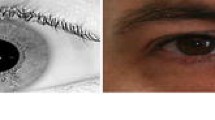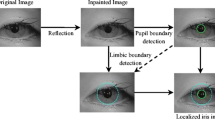Abstract
Iris recognition in uncontrolled environment acquired in different domains (cross-spectral and cross-sensor) poses a challenge for being considered for high-security applications. In this paper, a feature-set invariant to rotation, noise and illumination is proposed consisting of Zernike moments and polar harmonic transforms. Each of these is extracted from localized iris regions till 15th order on five publicly available databases: CASIA-IrisV4-Interval, IITD.v1, UPOL, UBIRIS.v2 and IIITD-CLI. The proposed method proves to be effective for near-infrared and visible images collected from different iris sensors, thus giving a superior performance as compared to existing techniques available in the literature in terms of receiver operating characteristic curve, accuracy, equal error rate and decidability index.
Similar content being viewed by others
References
UID Authority of India.: Role of biometric technology in Aadhaar enrollments. http://uidai.gov.in/images/FrontPageUpdates/role_of_biometric_technology_in_aadhaar_jan21_2012.pdf (2012)
Tan, C.W.; Kumar, A.: Adaptive and localized iris weight map for accurate iris recognition under less constrained environments. In: Proceedings of the IEEE 6th International Conference on Biometrics, Theory Application System (BTAS), pp. 1–7
Daugman, J.: High confidence visual recognition of persons by a test of statistical independence. IEEE Trans. Pattern Anal. Mach. Intell. 15(1), 1148–1161 (1993)
Bhateja, A.K.; Sharma, S.; Chaudhury, S.; Agrawal, N.: Iris recognition based on sparse representation and k-nearest subspace with genetic algorithm. Pattern Recogn. Lett. 73, 13–18 (2016)
Liu, Y.; He, F.; Zhu, X.; Liu, Z.; Chen, Y.; Han, Y.; Yu, L.: The improved characteristics of bionic gabor representations by combining with sift key-points for iris recognition. J. Bionic Eng. 12(3), 504–517 (2015)
Umer, S.; Dhara, B.C.; Chanda, B.: Iris recognition using multiscale morphologic features. Pattern Recogn. Lett. 65, 67–74 (2015)
Rai, H.; Yadav, A.: Iris recognition using combined support vector machine and Hamming distance approach. Expert Syst. Appl. 41(2), 588–593 (2014)
Umer, S.; Dhara, B.C.; Chanda, B.: A novel cancelable iris recognition system based on feature learning techniques. Inf. Sci. 406, 102–118 (2017)
Alvarez-Betancourt, Y.; Garcia-Silvente, M.: A keypoints-based feature extraction method for iris recognition under variable image quality conditions. Knowl. Based Syst. 92, 169–182 (2016)
Tan, C.W.; Kumar, A.: Accurate iris recognition at a distance using stabilized iris encoding and Zernike moments phase features. IEEE Trans. Image Process. 23(9), 3962–3974 (2014)
Masek, L.: Recognition of human iris patterns for biometric identification, pp. 1–7. http://www.csse.uwa.edu.au/opk/studentprojects/labor (2003)
Daugman, J.: How iris recognition works. IEEE Trans. Circuits Syst. Video Technol. 14(1), 21–30 (2004)
Teague, M.R.: Image analysis via the general theory of moments. J. Opt. Soc. Am. 70(8), 920–930 (1980)
Yap, P.T.; Jiang, X.D.; Chung, A.C.: Two-dimensional polar harmonic transforms for invariant image representation. IEEE Trans. Pattern Anal. Mach. Intell. 32(7), 345–351 (2010)
CASIA Iris Image Database. http://biometrics.idealtest.org
Kumar, A.; Passi, A.: Comparison and combination of iris matchers for reliable personal authentication. Pattern Recogn. 43(3), 1016–1026 (2010)
Dobes, M.; Machala, L.: Iris database, Palacky University in Olomouc, Czech Republic. http://www.inf.upol.cz/iris (2007)
Proenca, H.; Filipe, S.; Santos, R.; Oliveira, J.; Alexandre, L.A.: The UBIRIS.v2: a database of visible wavelength iris images captured on the move and at-a-distance. IEEE Trans. Pattern Anal. Mach. Intell. 32(8), 1529–1535 (2010)
Yadav, D.; Kohli, N.; Doyle, J.; Singh, R.; Vatsa, M.; Bowyer, K.: Unraveling the effect of textured contact lenses on Iris recognition. IEEE Trans. Inf. Forensics Secur. 9(5), 851–862 (2014)
Kohli, N.; Yadav, D.; Vatsa, M.; Singh, R.: Revisiting Iris Recognition with Color Cosmetic Contact Lenses. In: Proceedings of the 6th IAPR, pp. 1–5 (2013)
Dong, W.; Sun, Z.; Tan, T.: Iris matching based on personalized weight map. IEEE Trans. Pattern Anal. Mach. Intell. 33(9), 1744–1757 (2011)
Patil, C.M.; Patilkulkarani, S.: An approach of iris feature extraction for personal identification. In: International Conference on Advances in Recent Technologies in Communication and Computing, pp. 796–799 (2009)
Rahulkar, A.D.; Holambe, R.S.: Half iris feature extraction and recognition using a new class of biorthogonal triplet half-band filter bank and flexible k-out-of-n: a postclassifier. IEEE Trans. Inf. Forens. Secur. 7(1), 230–240 (2012)
Elgamal, M.; Al-Biqami, N.: An efficient feature extraction method for iris recognition based on wavelet transformation. Int. J. Comput. Inf. Technol. 2(3), 521–527 (2013)
Ahamed, A.; Bhuiyan, M.I.H.: Low complexity iris recognition using curvelet transform. In: IEEE Proceedings of the International Conference on Informatics, Electronics and Vision, pp. 548–553 (2012)
Demirel, H.; Anbarjafari, G.: Iris recognition system using combined histogram statistics. In: Proceedings of the IEEE International Symposium on Computer and Information Sciences, pp. 1–4 (2008)
Gragnaniello, D.; Poggi, G.; Sansone, C.; Verdoliva, L.: An investigation of local descriptors for biometric spoofing detection. IEEE Trans. Inf. Forensics Secur. 10(4), 849–863 (2015)
Ross, A.; Sunder, M.S.: Block based texture analysis for iris classification and matching. In: IEEE Proceedings of the Workshops on Computer Vision and Pattern Recognition, pp. 30–37 (2010)
Acknowledgements
The authors acknowledge Chinese Academy of Sciences-Institute of Automation (CASIA), China, Indian Institute of Technology, Delhi (IITD), University of Palack’eho and Olomouc and Soft Computing and Image Analysis Group (SOCIA Lab.), Department of Computer Science, University of Beira Interior, Covilhã, Portugal and Indraprastha Institute of Information and Technology, Delhi (IIITD), for providing iris databases used in this work. The authors are also grateful to anonymous reviewers for their constructive comments which improved the quality of the manuscript.
Author information
Authors and Affiliations
Corresponding author
Rights and permissions
About this article
Cite this article
Kaur, B., Singh, S. & Kumar, J. Iris Recognition Using Zernike Moments and Polar Harmonic Transforms. Arab J Sci Eng 43, 7209–7218 (2018). https://doi.org/10.1007/s13369-017-3057-2
Received:
Accepted:
Published:
Issue Date:
DOI: https://doi.org/10.1007/s13369-017-3057-2




